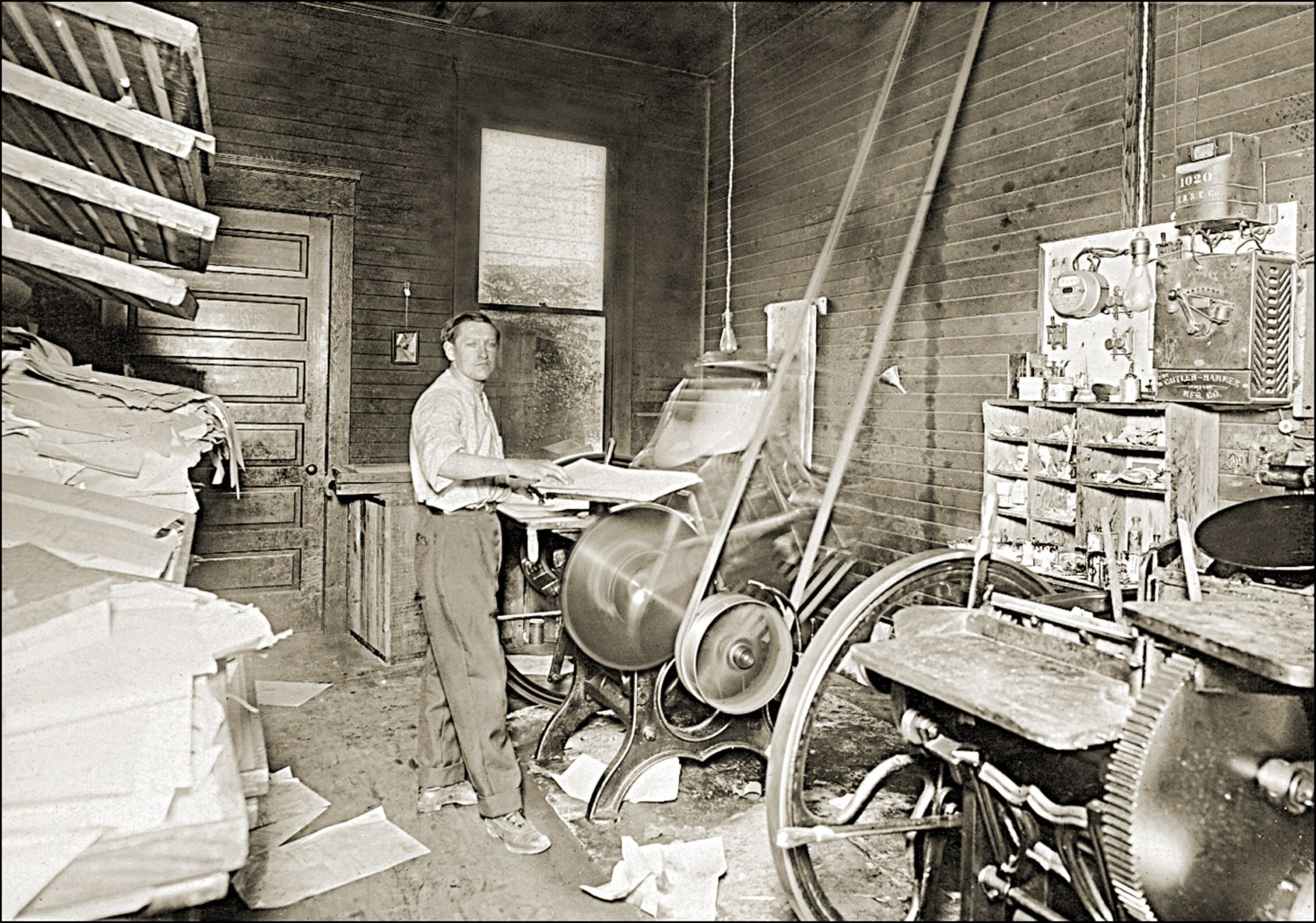The Evolution of Printers and Copiers: What You Need to Know
This is a subtitle for your new post

In the world of modern business, office equipment like printers and copiers play a crucial role in daily operations. These machines have come a long way from their humble beginnings, and understanding their evolution is essential for making informed decisions about office technology. Let's take a journey through time to explore the advancements in office equipment technology and what you need to know about them.
The Early Days: Simplicity and Innovation
Before the modern office printers and copiers we are familiar with today, the history of duplicating documents can be traced back to the invention of the printing press, which marked a revolutionary leap in information dissemination.
The Printing Press: A Game-Changer in Information Sharing
The printing press was invented by Johannes Gutenberg around 1440 in Mainz, Germany. This invention is often regarded as one of the most transformative in the history of human communication.
Gutenberg's printing press used movable type technology, where individual letters and characters could be rearranged to compose different texts. Prior to the printing press, books and documents were painstakingly copied by hand, making them rare and expensive. Gutenberg's innovation drastically changed this.
Here's how the early printing press worked:
- Movable Type: Instead of carving an entire page or document onto a single block, movable metal type allowed printers to arrange individual letters, numbers, and symbols into lines and pages.
- Ink and Press: Ink was applied to the type, and then paper was pressed against it, transferring the inked characters onto the page.
- Mass Production: With this method, books and documents could be produced at a much faster rate and in larger quantities than ever before.
Impact on Information Sharing
The invention of the printing press had several profound effects:
- Accessibility to Knowledge: Books and information became more accessible to a broader range of people. This led to increased literacy rates and the spread of ideas and knowledge.
- Standardization: The printing press helped standardize languages and the written word, leading to the development of modern languages and the dissemination of standardized texts.
- Cultural and Scientific Revolutions: The printing press played a pivotal role in the Renaissance, the Reformation, and the Scientific Revolution, as new ideas could be circulated widely.
- Birth of Newspapers: The printing press also contributed to the emergence of newspapers, which became vital for sharing news and information with the public.
- Industrial Revolution: The industrialization of printing and the creation of printing businesses marked the beginning of the publishing industry.
In essence, the early printing press transformed the way information was created, shared, and distributed. It democratized access to knowledge, paving the way for the rapid dissemination of ideas and the growth of human civilization. This historical context provides valuable insight into the evolution of office equipment technology and the profound impact it has had on businesses and society over the centuries.
The Birth of Laser Printing: A Technological Leap
The 1970s marked a pivotal era in office technology with the introduction of laser printing. One of the pioneering companies in this endeavor was the Xerox Corporation, which would change the landscape of document reproduction forever.
The Xerox 9700: A Game-Changer
In 1977, Xerox unveiled the Xerox 9700, which is widely recognized as the world's first commercially available laser printer. This innovation represented a quantum leap from the previous methods of document reproduction, particularly in office environments.
Here's what made the Xerox 9700 and laser printing in general so transformative:
- Clean and Precise Printing: Unlike traditional methods that often involved messy carbon paper or dot matrix printing, laser printing offered an exceptionally clean and precise way to put text and images on paper. It utilized a laser beam to create high-resolution images with remarkable accuracy.
- Speed and Efficiency: Laser printers were significantly faster than their predecessors. The Xerox 9700 could print at a rate of 120 pages per minute, which was a remarkable feat at the time. This increased productivity in offices and reduced waiting times for documents.
- Quality and Consistency: Laser printers produced high-quality output consistently, making them suitable for a wide range of professional documents, from letters and reports to graphics and charts. This ensured that documents looked sharp and professional.
- Reduced Maintenance: Laser printers required less maintenance compared to earlier technologies. They didn't rely on impact mechanisms that could wear out or require frequent ribbon changes, making them more reliable and cost-effective over time.
- Compatibility: Laser printers were compatible with a variety of media, including different paper sizes and types. This flexibility made them suitable for various office needs.
Global Adoption of Laser Printers
The introduction of laser printing, especially through Xerox's groundbreaking 9700 model, quickly gained recognition and adoption across offices worldwide. These machines became a staple in businesses of all sizes, from small enterprises to large corporations. They revolutionized the way documents were produced, copied, and shared within organizations.
As laser printing technology continued to advance, it contributed significantly to the growth of the modern office environment. The speed, precision, and reliability of laser printers became essential tools for businesses, streamlining document production and facilitating the exchange of information.
The Inkjet Revolution: A Colorful Evolution
The 1980s witnessed a profound transformation in the world of printing technology with the emergence of inkjet printers. These innovative devices harnessed a completely different approach compared to their predecessors and opened up exciting possibilities for color printing and enhanced flexibility.
Spraying Ink Onto Paper: The Inkjet Principle
At the heart of inkjet printing is a simple yet ingenious principle. Instead of using traditional methods involving ink-soaked ribbon or impact mechanisms, inkjet printers employ tiny nozzles to spray minuscule droplets of ink onto paper. This precision-controlled process allowed for a level of detail and color accuracy that was previously unattainable in the world of office printing.
Key Features of Inkjet Printers:
- Color Printing: One of the most significant advantages of inkjet printers was their ability to produce vivid, full-color prints. This was a game-changer for businesses and individuals who wanted to create eye-catching materials, including graphics, photographs, and marketing collateral.
- High-Quality Graphics: Inkjet technology excelled at rendering high-quality graphics. It could reproduce intricate details and subtle color gradations, making it suitable for a wide range of applications, from brochures to posters.
- Photo Printing: Inkjet printers became synonymous with photo printing due to their exceptional color accuracy and ability to reproduce lifelike images. This made them a popular choice for both personal and professional photography.
- Flexibility: Inkjet printers offered flexibility in terms of the types of media they could handle. They could print on various paper sizes and materials, including glossy photo paper and specialty stocks, expanding their utility.
- Cost-Efficiency: Compared to some earlier color printing methods, inkjet printing was often more cost-efficient. It didn't require expensive color ribbons or plates, and it minimized ink wastage.
Popularity and Impact
Inkjet printers quickly gained popularity in the 1980s and beyond due to their versatility and ability to meet the growing demand for color printing. They found applications in various sectors, including offices, graphic design studios, and even home environments.
The availability of high-quality, affordable color printing had a profound impact on businesses. It allowed them to produce marketing materials in-house, respond quickly to client needs, and create visually appealing presentations. For individuals, inkjet printers opened up new possibilities for creative expression through photography and graphic design.
Continued Evolution
The inkjet revolution didn't stop in the 1980s. Over the years, inkjet technology has continued to evolve, with improvements in print speed, color accuracy, and ink longevity. Today, inkjet printers are used in a wide range of applications, from home photo printing to large-format commercial printing.
Multifunction Machines: The Convergence of Office Functions
As technology continued to advance in the late 20th century and early 21st century, a significant development in the realm of office equipment was the emergence of multifunction machines. These devices marked a transformative shift by combining several essential office functions into a single unit.
A Jack-of-All-Trades Device
The hallmark of a multifunction machine, often referred to as an All-in-One (AiO) or Multi-Function Printer (MFP), was its ability to perform multiple tasks seamlessly:
- Printing: Like traditional printers, multifunction machines continued to offer high-quality printing capabilities. Whether it was documents, reports, or promotional materials, they could handle a variety of print jobs.
- Copying: Drawing from the legacy of photocopiers and laser printers, multifunction machines excelled in copying documents with precision and efficiency. This made them suitable for producing duplicates of critical paperwork.
- Scanning: Multifunction machines integrated scanning technology, allowing users to convert physical documents into digital formats. This was particularly valuable for archiving, sharing, and organizing documents.
- Faxing: Fax functionality was another standard feature of many multifunction machines. It enabled businesses to send and receive faxes, an essential communication tool in many industries.
The Advantages of Multifunction Machines:
- Space-Saving: One of the most apparent benefits was space efficiency. Combining multiple functions into a single device meant businesses could free up valuable office space previously occupied by separate printers, copiers, scanners, and fax machines.
- Cost Savings: Consolidating office equipment into a multifunction machine translated to cost savings. Businesses no longer needed to purchase and maintain multiple devices, reducing capital expenses and ongoing maintenance costs.
- Simplified Workflow: Multifunction machines streamlined office workflows. Users could initiate a print, copy, scan, or fax job from a single interface, simplifying the process and reducing the need to navigate between different devices.
- Environmental Benefits: Using fewer devices contributed to environmental sustainability by reducing energy consumption and electronic waste.
The Modern Office Hub
Today, multifunction machines have evolved further, incorporating advanced features such as wireless connectivity, cloud integration, and enhanced security measures. They have become the central hub for document-related tasks in modern offices, catering to the diverse needs of businesses of all sizes.
The Rise of Wireless and Mobile Printing: A Connectivity Revolution
The advent of Wi-Fi and mobile devices ushered in a new era for printers and copiers, transforming them from standalone peripherals into versatile, interconnected tools. Wireless and mobile printing technologies have become essential components of the modern office landscape.
Key Transformations Brought About by Wireless and Mobile Printing:
- Wireless Connectivity: Printers and copiers equipped with Wi-Fi capabilities can connect to a network without the need for physical cables. This wireless connectivity offers several advantages:
- Flexibility: Users can place printers anywhere within the Wi-Fi network's range, optimizing office layout and space utilization.
- Ease of Installation: Setting up wireless printers is far simpler and more convenient than routing cables throughout an office.
- Accessibility: Multiple users can access a single wireless printer, fostering collaboration and reducing the need for dedicated printers at individual workstations.
- Mobile Printing: Mobile printing technologies enable users to print directly from their smartphones, tablets, or laptops. This capability has been a game-changer for both remote work and on-the-go productivity:
- Remote Work: Employees can print documents from their home offices or while traveling, ensuring they have access to hard copies when needed.
- Collaboration: Mobile printing facilitates collaboration by allowing team members to print and share documents in real-time during meetings or brainstorming sessions.
- Convenience: Users can initiate print jobs from their mobile devices without the need to transfer files to a computer first, streamlining the printing process.
- Cloud Integration: Many modern printers and copiers are equipped with cloud integration features. This allows users to print documents stored in cloud storage platforms directly from the printer interface. It's particularly useful for remote workers and those who rely on cloud-based document management.
- Security Measures: With wireless and mobile printing, security has become a paramount concern. Printer manufacturers have responded by implementing security features such as user authentication, encryption, and secure print release. These measures ensure that sensitive documents are protected, even in wireless printing environments.
- Remote Management: IT administrators can manage and troubleshoot printers and copiers remotely, reducing downtime and maintenance costs. This capability is crucial for businesses with multiple locations or remote employees.
Impact on Remote Work and Collaboration:
The rise of wireless and mobile printing has had a profound impact on the way businesses operate:
- Remote Work: Wireless and mobile printing have made remote work more feasible and efficient. Employees can print documents at home or from remote locations, ensuring they remain productive and connected to the office.
- Collaboration: These technologies promote collaboration by allowing team members to print and share documents seamlessly during meetings or collaborative projects. This real-time interaction enhances decision-making and teamwork.
- On-the-Go Productivity: Mobile printing supports on-the-go productivity for employees who need to print documents while traveling or meeting with clients.
- Reduced Infrastructure Costs: Wireless and mobile printing reduce the need for dedicated printing infrastructure at each workstation, resulting in cost savings for businesses.
Managed IT Services and Security
In the age of information, cybersecurity is paramount. Printers and copiers are no exception. Modern office equipment is equipped with robust security features and can be integrated into managed IT services. This ensures that sensitive documents remain protected from potential threats.
Sustainability and Eco-Friendly Solutions
Today, the focus is not just on functionality but also on sustainability. Many businesses are opting for energy-efficient printers and copiers. Additionally, innovations like eco-friendly ink and paper options help reduce the environmental footprint of office equipment.
Looking to the Future
As technology continues to advance, the future of printers and copiers promises even greater efficiency, sustainability, and integration into the digital workspace. Businesses that stay informed about these advancements will be better positioned to optimize their operations and enhance productivity in the workplace.
In conclusion, the journey of printers and copiers from their inception to the present day is a testament to human ingenuity and the ever-evolving needs of businesses. Understanding this evolution is key to making informed choices about the office equipment that best suits your organization's goals and values.
At NextGen Automation, we are committed to staying at the forefront of office technology. If you're interested in learning more about how the latest advancements in printers, copiers, and managed IT services can benefit your business, don't hesitate to contact us for a free office assessment.
Industry News


For over 26 years we have provided leading edge print and IT services for offices in Western Canada.
For over 20 years we have provided leading edge products and solutions for offices in Western Canada.


